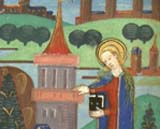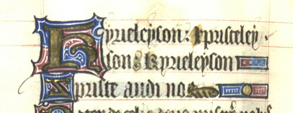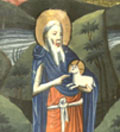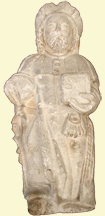The Litany and Suffrages
A Plea to the Saints
The Litany consists of a "roll call" of saints to whom the medieval reader prayed. Each invocation of a saint's name is followed by the plea "Ora pro nobis" ("Pray for us"). Saints served as earthly guardians, helpers, and nurses. More approachable than God, they could intercede in Heaven on behalf of humans. Medieval believers appealed to them for both spiritual and quotidian assistance, especially in dangerous situations: sickness, travel, and childbirth. Veneration of particular saints was carried out through pilgrimages to their shrines and devotion to their relics. Both the Litany and the Suffrages attest to the deep personal connection between saints and ordinary medieval people. The list of saints in the litany varies between different Books of Hours. Although some saints are ubiquitous, the inclusion of others who are lesser-known usually indicates a particular locale or the personal devotion of the individual who commissioned the book.
The litany in this early printed Book of Hours was decorated by hand in mauve, blue and gold. Litanies in manuscripts had normally been often decorated in this way as well, with the S of every "Sancte" colored, and with the spaces left by the relatively short invocations decorated with line fillers. Visually stimulating additions of color and pattern would have enlivened the medieval reader's regular, dutiful recitation of the saints' names. Images in the margin showing souls called up to heaven, or alternatively shunted into the mouth of hell, like those in this book, would have reminded readers of the grave importance of correct devotional practices.
Symbols and Medieval Cults of the Saints
The Suffrages are additional pleas for help from specific saints. Even more than the Litany, the choice of saints for the Suffrages can reveal the devotional preferences of a book's owner. It can also indicate the popular saints in the owner's community. Each Suffrage begins with an invocation of the chosen saint, followed by a longer prayer (oratio). This prayer usually recounts some biographical event or praises an aspect of the saint's holiness. It continues with a plea to the saint to intercede with God on behalf of the reader. Depictions of saints often included characteristic symbolic attributes that both allowed instant recognition among medieval readers, and reminded them of their life stories and distinctive qualities.Saint Michael
The archangel Michael is shown clad in armor, holding a set of scales and weighing two naked souls. Michael's warlike attire attests to his special patronage of Christian soldiers. Medieval men in the midst of battle on land or sea looked to him eagerly for protection. The symbol of the scales reminded the pious of Saint Michael's power of judgment; one liturgical text stated that he was even able to rescue souls from the depths of Hell. In this image the elevated left-hand soul has been deemed worthy of salvation, while the lower right-hand soul is doomed to damnation.Saint Barbara
 Saint Barbara became one of the most popular saints in the later Middle Ages, particularly in France. She is depicted in both of these images with a tower, her characteristic attribute. According to her legend, Barbara was confined to a tower by her father, Dioscurus, and lived there as a hermit. In her piety she asked the builders to construct a third window to symbolize the Holy Trinity. Enraged at her conversion, Dioscurus brought her to the top of a mountain and killed her. He was promptly struck dead by lightning from Heaven, and as a result Saint Barbara became the protectress of those in danger of sudden death, such as miners or gunners. Her association with the tower also made her the patron saint of architects and builders.
Saint Barbara became one of the most popular saints in the later Middle Ages, particularly in France. She is depicted in both of these images with a tower, her characteristic attribute. According to her legend, Barbara was confined to a tower by her father, Dioscurus, and lived there as a hermit. In her piety she asked the builders to construct a third window to symbolize the Holy Trinity. Enraged at her conversion, Dioscurus brought her to the top of a mountain and killed her. He was promptly struck dead by lightning from Heaven, and as a result Saint Barbara became the protectress of those in danger of sudden death, such as miners or gunners. Her association with the tower also made her the patron saint of architects and builders.





